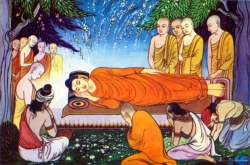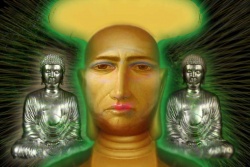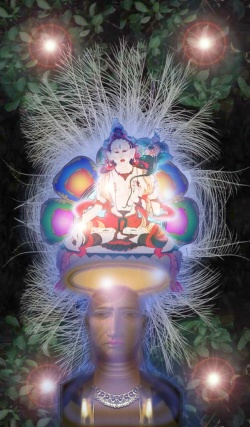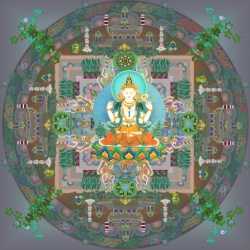The Buddhist Theory of Inference
Prof. S. R. Bhatt Department of Philosphy, University of Delhi, India
The epistemological thinkers in India have generally adopted a causal approach to knowledge. Every knowledge is taken to be an occurrence, an outcome of a particular causal complex (Kaara.na saamagrii) in which the causal condition acting as an instrumental cause (Kaara.na) is known as Pramaa.na. Pramaa.na is the mode of knowing. The Buddhist thinkers do not entertain the distinction between Pramaa.na and its outcome (Pramaa.na phala=pramaa) mainly because this distinction is not needed in their epistemological set up. As opposed to the school of Nyaaya which maintains such a distinction because of its presupposition that pramaan.na is the ground for the truth of a pramaa (maanaadhiina meyasiddhi.h) which is its phala (outcome), the Buddhists repudiate this distinction because for them a reference to the object of knowledge (prameya) is the ground for the truth of pramaa.[1] Moreover, they maintain that no rigid separation is possible between the act of cognising and the cognition of the object.[2]
Anumaana, which in the Buddhist tradition is one of the two pramaa.nas, is at once a mode of knowing and a way of reasoning. Thus it has an epistemic as well as a logical aspect.
The word anumaana literally means ‘a knowledge which follows’. This means that inferential knowledge is necessarily a knowledge which is to be preceded by some other knowledge. In other words, anumaana consists of two stages, one pertaining to the preceding and the other to the succeeding knowledge. But the two cases of knowledge must have a particular type of relationship known as li"nga-li"ngiblijva which implies that the succeeding one should necessarily come from the preceding. The preceding knowledge has to be in the form of li"nga. A li"nga is defined as that which is a necessary mark of something other than itself.[3]
‘Li"ngin’ stands for that which is marked by li"ngin. Between li"nga and the li"ngin there is always a ga"mya-gamaka-bhaava which can roughly be regarded as the relation of entailment such that every case of the presence of li"nga is necessarily a case of the presence of li"ngin and every case of absence of li"ngin is the case of the absence of li"nga.[4]
In the Buddhist tradition li"nga and li"ngin are in the form of concepts (vikalpas) and not objects or events or metaphysical reals as they are taken in the Nyaaya tradition. Between any two concepts there will be ga"mya-gamaka-bhaava if and only if they have avinaabhaava i.e., necessary connection. It is the presence of the necessary connection which is the basis for the passage from the one to the other. This relationship of avinaabhaava is also known as vyaapti. Vyaapti therefore constitutes the very basis of the inferential process.[5]
Nyaaya analysis of Anumaana: In order to have a better understanding of the Buddhist analysis of 'anumaana' it will be worthwhile if we discuss in brief the Nyaaya, analysis of ‘anumaana'. According to Nyaaya, anumaana is the knowledge of an object on the basis of the cognition of its mark along with a remembrance of a previous knowledge concerning an invariable and unconditional relation between the object and its mark. In other words, in every case of anumaana in the preceding cognition, which can be treated as a premise, there are two elements, viz., (i) perceptual cognition of the li"nga (pak.sadharmataa), (ii) the remembrance of unconditional and invariable relation between the li"nga and the li"ngin (vyaapti). The perceptual cognition of the mark leads to the remembrance of its unconditional and invariable relationship with the lingin resulting in a synthesised knowledge. The synthesis of both these stages is named as paraamar'sa, which is therefore defined as ‘vyaapti vi'si.s.ta pak.sadharmataaj~naanam’. The act of paraamar'sa can thus be said to consist of three elements, viz., the knowledge of vyaapti, the knowledge of pak.sadharmataa and the knowledge of the vyaapti qualifying .sadharmataa. It is only this unification of pak.sadharmataa and vyaapti in paraamar'sa which entails inferential knowledge. Thus though vyaapti is one of the causal conditions, and a necessary causal condition (kaara.na), yet it is not the sufficient condition of inference. The sufficient condition (vyaapaara) is paraamar'sa only.
Buddhist rejection of paraamar'sa: The Buddhist logicians do not draw a sharp distinction between the pak.sadharmataa and vyaapti in the way in which the Nyaaya logicians do. According to them, pak.sadharmataa and vyaapti are both comprehended under the concept of trairuupya li"nga and therefore there is no point in talking of vyaapti qualifying pak.sadharmataa. Thus the Nyaaya notion of paraamar'sa is not acceptable to the Buddhists.
Constituents of inference: In the Buddhist analysis, the process of inference involves three basic terms and their interrelations. This is quite evident from the following definition of inference given by Dharmakiirti, "Triruupaalli"ngaada numeye yaj j~naanam tatsvaarthaanumaanam".[6] The three terms are pak.sa (anumeya), hetu (li"nga) and saadhya (li"ngin).
Pak.sa: Pak.sa is the subject under consideration in the inferential reasoning. Every inference pertains to some individual or class of individuals about which we want to prove something. Hence pak.sa is that individual or class of individuals about which we want to establish something. It is also named as anumeya because it is the object about which something is to be inferred. In a special sense it also means the underlying substratum (dharmin) to which saadhya is to be ascribed as a property. That is why Dharmakiirti defines anumeya as '[[Jij~naasitavi'se.sa saadhya] dharmii]]’.
Hetu: The other term involved in the process of inference is li"nga or hetu. In fact it is the pivotal element in the process of anumaana. It is the necessary mark which leads to inference of its marked object. Hetu (li"nga) has three formal characteristics - the satisfaction of which alone enables it to act as a sufficient reason for the inference of its marked object. A hetu which possesses these three characteristics is known as sahetu.
Saadhya: The third entity involved in the inferential process is saadhya or li"ngin. It is this which constitutes the property (dharma) which is to be inferred in relation to the pak.sa.
Spank.sa: Another significant concept which is given in the analysis of the inferential process is sapak.sa. Sapak.sa means an object similar to pak.sa. In other words, all those objects which possess the property which is to be inferred known as sapak.sa; for example, if fire is the predicate which is to be inferred in relation to a hill, then all those instances like kitchen etc., where fire is known to be a predicate, constitute sapak.sa. A sapak.sa is similar to pak.sa in this sense only that both of them comprehend a common property.[8]
Asapak.sa: A case which is not similar to pak.sa is regarded as asapak.sa.[9] In other words, asapak.sa is that which is never a possessor of the property commonly possessed by pak.sa and sapak.sa. Asapak.sa can be of three types:[10]
Vyaapti: The entire inferential process, as we have said above is based upon the relation between li"nga and li"ngin, which can be understood in terms of necessary dependence (avinaabhaavaniyama) and which is technically known as vyaapti. The Buddhist conception of vyaapti stands for an invariable necessary connection. Vyaapti is a necessary bond because of the fact that it is rooted in what is technically, known as svabhaava pratibandha or existential dependence. Existential dependence means dependent existence. It may be in the form of a causal relation or an analytical enactment. For example, the dependence of effect on its cause enables us to infer the cause the moment the effect is known to us. Similarly, an analytically deduced fact by its very essence depends upon the fact from which it is deduced. Thus there is svabhaava pratibandha between cause and effect and between the deduced object and that from which there is deduction. The example of the former type is the relation between smoke and fire and of the latter type is the relation between rose and flower. We can deduce one fact from another only if there is existential dependence. It can be asked why is it that we can deduce one fact from another only if there is existential dependence.[11] The answer given by the Buddhist logicians is that this is so because effect which is not dependent upon another object can not be invariably and necessarily concomitant with the later. In other words, if effect is not tied up by its existence to another object, it can not be necessarily concomitant with the latter. There will be no invariability (avyabhicaara). Thus the possibility of deducing one fact from the other depends upon an invariable and necessary connection which precludes the existence of the one without the existence of the other. Therefore, if two facts are existentially connected we can assert that one of them can not exist independently of the other and therefore from the presence of the one follows the presence of the other.
Kinds of li"nga: There are three varieties of li"nga, viz., anupalabdhi, svabhaava and kaarya. The li"ngin is a sort of predicate and a predicate is either denied or affirmed. When it is denied, this is done on the basis of the non-existence of its mark. Such a mark is known as anupalabdhi hetu or anupalabdhi li"nga. When it is affirmed, its mark is either existentially identical with it or if different, it is its effect. In the former case its 1i"nga is known as svabhaava hetu or svabhaava li"nga and in the latter case it is known as kaarya hetu or kaarya li"nga.
Anupalabdhi: Anupalabdhi has been defined as non-cognition of such an object which otherwise fulfils the conditions of cognizability. For example, a jar is an object which fulfils the condition of cognizability. If at a particular place there is non-cognition of jar, this enables us to infer its non-existence. So here non-cognition of the jar is the li"nga and non-existence of the Jar is the li"ngin. The non-cognition (of a thing) is to be regarded as the li"nga for the non-existence (of that thing) which is its li"ngin on the ground that if the things were present, it would have necessarily been perceived when all other conditions of perceptibility are fulfilled. If inspite of all the conditions of perceptibility being present, if a thing is not perceived, we can legitimately infer its non-existence.[12]
Svabhaava li"nga or Svabhaava hetu: The second type of li"nga is known as svabhaava li"nga or svabhaava hetu. The svabhaava hetu is defined as that whose mere existence is sufficient for the deduction of the saadhya.[13]. For example, in the judgement, "It is a flower because it is a rose" the reason, namely, rose is sufficient for the deduction of flower. Here the terms 'rose' and 'flower' have one and the same object for their reference though they may have different meanings. It is this sameness of reference known as taadaatmya which is responsible for the existential tie between rose and flower.
Kaarya li"nga or Kaarya hetu: The third type of li"nga is kaarya li"nga or kaarya hetu, which is in the form of an effect. It necessarily presupposes its cause like smoke necessarily implying the existence of fire. The causal connection is given to us in our experience of both anvaya and vyatireka type i.e., on the basis of agreement in presence and agreement in absence between two phenomena.[14]
Three types of anumaana: Since there are three types of li"nga, there are three types of anumaana, viz., Anupalabdhi, Svabhaava and Kaarya.
Though a li"nga may be either in the form of anupalabdhi or svabhaava or kaarya, every li"nga necessarily possesses three marks. The doctrine of three marks of a li"nga, technically known as trairuupyavaada, is of great logical significance in the Buddhist theory of inference.
The Concept of trairuupya: The concept of li"nga provides the starting point of the inferential process. If the two stages of the inferential process are classified as premise and conclusion then li"nga can be regarded as the most basic concept in the premise. The process of inference consists of a transition from li"nga to li"ngin. That is why Dharmakiirti regards li"nga as the very basis of inference.[15]. Regarding the function of li"nga Dharmottara aptly remarks, "Therefore the function of the logical mark, owing to which it is able to create cognition of not directly known things, is nothing else than the necessity of an invariable concomitance between the perceived mark and the non-perceived object. It follows that the word 'necessary' must be referred to all the three aspects in which the mark manifests itself, since all these three viz. (i) the positive concomitance of the mark with the deduced predicate; (ii) its contraposition (or the inverted concomitance of their negations) and (iii) the presence of the thus characterized mark upon the subject of the conclusion represent the essence of the function performed by a logical mark and must be ascertained as being necessary".[16]
In this passage Dharmottara refers to a very significant term, viz., naantariiyakartva which has also been referred to by Uddyotakara, a Nyaaya thinker in his Nyaava- Vaartika. He has referred to a definition of anumaana given by some thinkers as "Naantariiyakartha dar'sanam tadvido anumaana"m" i.e. "the experience of a thing, which is inseparably connected with another thing is the instrument of inference for one who knows that they are inseparably connected?" The concept of naantariiyakatva is perhaps explicated by Dignaaga in the form of trairuupya. The term naantariiyakaartha implies presence of hetu in the pak.sa, its presence in the sapak.sa and its absence in the vipaksa, because in the absence of such a situation there can not be inseparable connection between hetu and saadhya.
According to Buddhist logic the li"nga is, thus, characterised by three essential characteristics. In fact in the history of Indian Logic we find different views with regard to the essential characteristics of li"nga. Whereas the Nyaaya tradition insists on five characteristics and the Jaina tradition regards only one characteristic, the Buddhist tradition maintains that there are three and only three essential characteristics of a li"nga. Every li"nga must possess all the three characteristics simultaneously (trilak.sa.na hetu). Then and then only it can be regarded as a li"nga, and be made use of in the process of inference. That is why Dharmakiirti, while defining anumaana, writes triruupaalli"ngaad etc.
Development of the Concept of trairuupya: The first systematic formulation of the doctrine of trairuupya is said to be done by Dignaaga. Uddyotakara, in his Vaartika cites Dignaaga's formulation of trairuupya as follows:
"anumeya’tha tat-tulye sadbhaavo naastitaa sati".[18]
i.e. existence in the anumeya (pak.sa), in what is like the pak.sa (sapak.sa) and absence in what is not like the pak.sa (vipak.sa). Prof Stcherbatsky has rendered in English Dignaaga's version as follows:[19]
1. Its presence in the subject of the inference.
2. Its presence in similar instances.
3. Its absence in the dissimilar instances.
It was Dharmakiirti who further regulated these three characteristics introducing more rigour. He did so by putting and emphasising the word 'eva' to each of the three marks, and by qualifying the entire expression by the word ni'scitam. The other modification he introduced is about the use of the terms sapak.sa and asapak.sa to remove all sorts of ambiguity. Thus his formulation is as follows:[20]
1. Li"ngasyaanumeye sattvameva.
2 .Sapak.sa eva sattvam.
3. Asapak.se caasattvameva ni'scitam.
In English it can be rendered as follows:
1 . Existence only (never non-existence) in the pak.sa.
2. Existence in all those things which are similar to pak.sa (never in things which are not similar to pak.sa).
3. Only non-existence (never existence) in things which are not similar to pak.sa.
Professor Stcherbatsky[21] has rendered Dharmakiirti's version in three stages as follows:
I stage:
(i) The presence of the Reason in the Subject, its presence ‘just’ i.e., never absence.
(ii) Its presence in Similar Instances, ‘just’ in similars, i.e., never in dissimilars, but not in the totality of similars.
(iii) Its absence from dissimilar instances, its absence ‘just’ i.e., never presence, absence from the totality of the dissimilar instances.
It is easily seen that the second and the third rule mutually imply each other. If the reason is present in the similar instances only, it also is absent from every dissimilar case and if it is absent from every dissimilar case, it can be present in similar instances only, although not necessarily in all them. Nevertheless both the rules must be mentioned, because, although in a correct inference the application of the means the application of the other, in a logical fallacy infringements sometimes carry different results. Dharmakiirti, moreover, adds the word 'necessary' to the formulation of each rule. Their final form will thus be:
II stage:
(i) The necessary presence of the Reason in the Subject's totality.
(ii) Its necessary presence in Similars only, although not in their totality.
(iii) Its necessary absence from Dissimilars in their totality.
III stage: The third and the most succinct formulation as follows:
(i) In Subject wholly.
(ii) In Similar only.
(iii) In Dissimilar never.
Though the doctrine of trairuupya has been one of the most significant elements in Buddhist logic, the formulation of it both by Dignaaga and by Dharmakiirti does not seem to be free from ambiguity. That is why the interpretation of ‘trairuupya’ has always been controversial. Prof. Chi is to the point when he remarks that, "The trairuupya seems to have been respected as one of the most important doctrines in Indian Logic, and yet elaborate interpretations of distinguished scholars can hardly convey any sense to their readers".[22]
The discussions recorded in surviving documents are lengthy. Some were made by commentators who tried hard to give plausible interpretations without caring very much what Dignaaga should have meant to say; some others were made by Dignaaga's opponents such as Uddyotakara, who might have twisted his words in order to attact him.
Uddyotakara's Objection to Dignaaga's Formulation: The formulation of the first ruupa in Dignaaga viz., 'Anumeye sadbhaava' was not free from ambiguity and as a consequence of what Uddyotakara examined its two possible interpretations viz., (1) the hetu is present in the subject only, (2) the hetu is only present in the-subject. To point out the difference in the two interpretations the following symbolic formulation may be helpful.
(i) b is present in a only =every b is a = no non-a is b.
(ii) Only b is present in a = every a is b = no non-b is a.
From the above it is quite evident that these two interpretations do not mean the same thing and therefore, the formulation by Dignaaga was replete with ambiguity.
The formulation of the second ruupa given by Dignaaga was also ambiguous in the same way which led Uddyotakara to interpret it in two different ways, viz.,
(IIa) The hetu is present in similar instances only.
(IIb) The hetu is present in all similar instances.
In the same way Dignaaga's formulation of the third ruupa was subjected to two different interpretations by Uddyotakara as follows:
(IIIa) Only the hetu is absent in the dissimilar instances.
(IIIb) The hetu is absent in the dissimilar instances only.
Though Dignaaga had given his unambiguous version his ‘[[Hetu] cakra damaru]]’ where the presence or the absence of hetu in relation to anumeya was well quantified, perhaps he did not do so in the Pramaa.na-samuccaya, from where Uddyotakara might have quoted him.
Dharmakiirti's Interpretation: The ambiguity of non-quantification which vitiated Dignaaga's formulation was sought to be removed by Dharmakiirti by adding the restrictive word 'eva'. But unexpectedly his modification caused further ambiguity. That is why commentators from Dharmottara onwards had to struggle hard to interpret it in a satisfactory way. Dharmottara had to face a dilemma on this account while commenting upon the second and third, ruupas. The second ruupa apparently meant only in the sapak.sas hetu must be present but by implication this meant that hetu must be absent in all vipak.sa. But then second ruupa will be another way of saying the same thing as the third ruupa. This renders the third ruupa superfluous but this was not the intention either of Dignaaga or of Dharmakiirti.
Points of Ambiguity in the Formulation of Trairuupya: There are three main reasons for the misinterpretation of the theory of trairuupya. The first reason for the ambiguity was the use of terms like 'anumeya' which may either mean 'saadhyadharma’ or 'saadhyadharmin’. A similar ambiguity was present in the use of the term 'eva' which was introduced as a restrictive predicate. In the first ruupa, as it is formulated by Dharmakiirti, the word 'eva' could be applied as a restriction to the occurrence of the word 'anumeya' or of the word ‘li"nga’ or of the word 'sattvam'. In the formulation of the second ruupa the word 'eva' can be understood as restriction of either sapak.sa or li"nga or sattvam. Similarly in the formulation of the third ruupa 'eva' can be a restriction either for asapak.sa or for li"nga or for a sattvam. It was Dharmottara who later on tried to remove this ambiguity of placement of eva.
The second reason for the ambiguity in the formulation of trairuupya is non-availability of Dignaaga's works in their complete form. From the fragments what one gets is only disconnected and isolated thoughts and not the complete theory.
The third reason for the ambiguity has been the twist given by Uddyotakara to Dignaaga's position.
Chinese Formulation of Trairuupya: Prof. Chi in his book 'Buddhist Formal Logic' has given the Chinese version of trairuupya which seems to be free from ambiguity.
It is as follows[24]:
(i) The 'pervasive presence' of the hetu in the subject.
(ii) The 'necessary presence' of the hetu in some similar instances.
(iii) The 'pervasive absence' of the hetu from dissimilar instances.
In the above rendering the use of the word 'pervasive' in the first and the third ruupas and of the word 'necessary' in the second ruupa helps us in the removal of ambiguity. The words ‘pervasive presence' and 'pervasive absence' refer to the distribution of quantification of hetu. Similarly the phrase ‘necessary-presence' means 'assured presence' or 'not failing to be present'. Prof. Chi has defined the notion of 'pervasive presence' as follows:
"pervasive presence of b in a"
= "b is present in every a"
= "every a is b
The notion of 'pervasive absence' is defined by him as follows:
"pervasive absence of b from a"
= "b is absent from every a"
="every a is non b
="no a is b
The notion of 'necessary presence' is defined by him as follows:
"Necessary presence of b in a
= "b is present in at least one a, at most in every a"
="at least one a, at most every a is b.
In accordance with the above understanding he interprets trairuupya as follows:
1st ruupa: "The property g is present in everything which possesses the property f.
="everything which possesses the property f possesses the property g".
= For every x, x is an f implies x is g-.
2nd ruupa: "There is at least one occasion in which the property g is present in a thing which possesses the property h, apart from the thing which possesses the property f , which remains to be proved".
=Apart from the thing which possesses the property f, at least one thing which possesses the property h possesses the property g",
="For some x which is not f, x is both an h and g
3rd ruupa: "There is no occasion in which the property g is present in things which possess the property non-h."
= "Nothing which possesses the property non h possesses the property g".
="For no x, x is both non -h and a g." On basis of this interpretation, Prof. Chi proposes to resolve Dharmakiirti's dilemma on the interpretation of 'eva' only in the second ruupa as follows:
‘only presence'
"only presence of the property of the hetu in similar instances but not otherwise".
="only presence of the property of the hetu in similar instances but utter absence of the property of it in all similar instances".
"The presence of the property of the hetu in at least one similar instance".
Understood in this way the second ruupa does not overlap with the third ruupa and the problem of redundancy is overcome.
'Trairuupya and Hetu Cakra': The doctrine of trairuupya can unambiguously be understood only in the context of hetucakra, another doctrine propounded by Dignaaga in his small tract called 'Hetucakra damaru'. The application of 'hetucakra' to the second and third ruupa gives the following which is represented by Prof. Chi in a diagram as under:
Sapak.savyaapaka(1)
Sapak.sa-evasattvam(5)
Vipak.saa.rtti(2)
Sapak.saikade'sav.rtti(3)
Asapakse cisattyameva(6)
Vipak.saiv.rtti(4)
The above diagram can be explicated in ordinary language as follows:
(1) Pervasive presence in similar instances.
(2) Absence in dissimilar instances.
(3) Partial presence in similar instances.
(4) Absence in dissimilar instances.
(5) Unfailing presence in similar instances.
(6) Necessary absence in dissimilar instances.
There are three significant systems of logic in India, viz, Buddhist, Nyaaya and Jaina. All the three systems have differed with regard to the required ruupas of hetu. The Buddhist as we have seen, insist on three ruupas only, but the Naiyaayikas emphasise upon five ruupas of hetu and the Jainas maintain that only one ruupa of hetu is necessary.
NyaayaTheory of Pa~ncaruupa: The Nyaaya logicians emphasise the fact that hetu or li"nga is the central element in the inferential process. It is related to pak.sa as well as saadhya and it occurs in all the significant premises, viz., hetu, udaahara.na and upanaya. The validity of inference depends a great extent on hetu and that is why a fallacious inference is known as having hetvaadbhaasa. The Nyaaya, logicians, therefore, have taken great pain in expounding the characteristics of a good hetu, because if the hetu is sadhetu, the inference will be valid and if it is asadhetu, the inference will be invalid. The Naiyaavikas enumerate the following conditions of a sadhetu.
(1) Pak.sadharmatvam: Hetu must be a dharma or characteristic of pak.sa. This means that the hetu should have adhikara.na in pak.sa, i.e., it should reside in or be related to pak.sa. Thus the pak.sa should never be without hetu. And nothing can be a pak.sa if there is no hetu related to it.
(2) Sapak.sasattvam: Hetu must be distributively related to Saadhya. This means that wherever hetu exists in all such cases, saadhya must be present. This means that the necessary condition for the occurrence of hetu, is the occurrence of saadhya.
(3) Vipak.sasattvam: Hetu must be absent in all cases in which the sadhya is absent. This means that the absence of saadhya necessarily implies the absence of the hetu. Hetu canot be present in the absence of saadhya. So in all vipak.sas i.e. where saadhya is absent hetu also must be absent.
(4) Abaadhitavi.sayatvam: Hetu should not be such as to be contradictory to or incompatible with the nature of saadya. This is so because the function of hetu is to establish, but if it is incompatible with saadhya, it will fail to do so.
(5) Asatapratipak.satvam or Aviruddhalvam: Hetu should not be such which can have a rival hetu which is competent to invalidate it.
Of course Naiyaayikas make it clear that all these five ruupas are not simultaneously present in all hetus. For example, in a kevalaanvayii inference the third condition will not be applicable. Similarly in the kevalavyatirekii inference, the second condition will not be applicable to its hetu. Hence it has been said that a sadhetu is one that satisfies the five or at least the four conditions as explained above.
If we compare the Nyaaya theory of pa~nca ruupa hetu with the Buddhist theory of trairuupya, we find that the first three ruupas of the Naiyaayikas correspond to the trairuupya of the Buddhists. Of course the details in the formulation of these three ruupas are very much different in the two traditions, still we can regard them as having some rough correspondence. But the last two ruupas of the Nyaaya, theory are not accepted and will not be acceptable to the Buddhists. Now it can be asked as to why the Buddhists do not accept the last two ruupas? The reason is that the Buddhists believe in the theory of pramaa.navyavasthaa which is opposite to the Nyaaya theory of pramaa.na-sa"mplava. So verdict of one pra"maa.na can be contradicted by the other pramaa.na in the Nyaaya position but it can not be so in the Buddhist position. Therefore there is no possibility of satpratipak.sa in the Buddhist position. Secondly, the basis of inference according to the Buddhists is li"nga-li"ngi-bhaava between any two concepts. We shall never establish li"nga-li"ngi-bhaava if they are of opposite nature. Therefore, there will never be an occasion for abaadhitavi.sayatvam. Though there has been a lot of controversy between the Buddhists and the Naiyaayikas as to whether or three ruupas are to be accepted, or five ruupas are to be accepted, the whole controversy appears to be futile because there are two different traditions having different types of requirements. The Nyaaya tradition stands in need of five ruupa whereas in the Buddhist tradition only three ruupas are possible and therefore, the theories of pa~ncaruupa hetu and trairuupya hetu are perfectly in order in their respective system.
Jaina Criticism of Trairuupya: The Jaina tradition maintains that hetu has a unitary nature and therefore, it possesses only one ruupa. Hetu is defined as that which is inseparably connected with saadhya. This means hetu is that which is present only in the presence of saadhya and which is necessarily absent in the absence of saadhya. Akala"nkadeva defines hetu as "saadhyaavinabhaavavinibodhaikalak.sa.na"[25]. Some Jaina logicians have described this fact with the help of another concept, viz, "anyathaanupapatti". Vaadidevasuuri defines hetu: "ni'scitaanyathaanupapattyeka lak.sa.nohetu.h"[26]. The term "anyathaanupapatti" means that in the absence of saadhya (anyaatha) there should be absence of hetu (anupapatti). By implication it means that hetu should be present only in the presence of saadhya. So to be saadhyaavinaabhaavinii is the sole characteristic of a hetu.
The Jainas have not only insisted on one and the only one characteristic of hetu but they have also put forth a refutation of the theories of 'trairuupya' and 'pa~ncaruupa'.
Paatrasvaamin seems to be the first Jaina scholar, as quoted by Akala"nka and Vidyaananda who attempted the refutation of the doctrine of trairuupya as follows [27]:
"Anyathaanupapannatva"m yatra tatra traye.na kim,
Naayathaanupapannatva"m yatra tatra traye.na kim."
In the above kaarikaa Paatrasvaamin emphatically maintains that 'anyathaanupapannatva"m' is the only ruupa of hetu. If is present then what is the need of three ruupas, and if it absent then what is the purpose of having three ruupas. Following Paatrasvaamin all subsequent Jaina logicians like Akala"nka, Vidyaananda, Prabhaacandra, Vaadidevasuuri, Anantaviirya, Hemacandra, etc. have also refuted the doctrine of trairuupya. The above mentioned kaarikaa of Paatrasvaamin has been quoted by 'Saantarak.sita in his Tattvasa"ngraha in the form of puuvapak.sa presenting the Jaina position and there he has refuted the Jaina objections against 'trairuupya' [28]. The basis objection put forth by the Jainas is that even an invalid hetu, may have the three ruupas. For example, the argument, "There is smoke on the hill because there is fire" has all the three ruupas, viz. pak.sadhamattvam, sapak.sa-sattvam and vipak.sa-sattvam, but still it is logically invalid because there is no necessary connection (avinaabhaava) between fire and smoke. In other words, there may be fire and smoke on the hill and so the condition of pak.sasattvam is fulfilled. Similarly there can be fire and smoke in the kitchen and condition of sapak.sa-sattvam is fulfilled. Likewise there will be no fire and smoke in a lake and the condition of vipak.sasattvam is also fulfilled. Even then fire is an invalid hetu for smoke. Of course, the Buddhists may point out that the trairuupya should be understood as qualified by avinaabhaava and there is no avinaabhaava between fire and smoke because there may be fire without smoke, for example, in an electrical hearth. So the relation of fire and smoke is conditional (sopaadhika) and not unconditional (niruupaadhika). To this Jainas have replied that if avinaabhaava is to be emphasised, then this amounts to accepting their position, which means hetu has only one ruupa and not three ruupas. The Jaina point of emphasis is that the hetu in an argument is valid and competent to prove the saadhya not because the two exist in the same pak.sa as the Naiyaayikas say but because the two are inseparably related. In the words of Jaina logicians the hetu is not cognised otherwise than in connection with the saadhya. Accordingly, so far as the essential characteristics of a valid hetu are concerned, it is this one and this one only.
'Saantarak.sita in his Tattvasa"ngraha has stated and examined Paatrasvaamin's arguments in great detail. According to him the concept of anyathaanupapatti is only an abbreviated form of trairuupya, the like of which has also been given by Dignaaga as 'hetordharminyevaagamyate'.[29]
REFERENCES
1. (a) Savyapaara-pratiitatvaat pramaana"m phalamevasat, P.S. I. 8.
(b) vi.sayaakaarataivaasya pramaana"m tena miiyate. P.S. I. 9.
2. See P.S. V. I. 8 Hattori's translation, p. 28.
3. Li"ngyate gamyate iti li"nga.h N. B. T. p. 21.
4. Ni'scayaapek.so hi gamya-gamaka bhaava.h, N.B. T. p. 31.
5. Na hi yo yatra svabhaavena na pratibaddha.h sa tamaprati baddhavi.sayamava'syameva na vyabhicaratiiti naasti tayora vyabhicaara niyama.h. Avinabhaavaniyama.h. Avyabhicaara niyamaacca gamyagarnaka-bhaavah. N.B.T., p. 30.
6. N.B. Ch- II. p. 21.
7. Ibid., p. 24.
8. (a) saadhya-dharma-saamaanyena samaano'rtha.h sapak.sa.h, N.B. Ch. II. p.24.
(b) samaana.h saad.r'so yo'rtha.h pak.se.na sa sapak.sa N.B.T., p. 24.
9. Na sapak.so' sapak.sa.h ... N.B. Ch. II. p. 25.
10. Tato 'nyastadviruddhastadabhaa'sceti, Ibid.
11. Svabhaava-pratibandhe hi satyartho'itham garnayeta, N.B. Ch. II. p. 29.
12. Upalabdhi lak.sa.na praaptasyaanupalabdheriti, N.B. Ch. II. p. 26.
13. Svabhaava.h svasattaamaatrabhaavinii saadhya-dharmehetu.h.N.B. Ch. II. p. 28.
14. Kaarya-kaara.na-bhaavo loke pratyak.saanupalambhanibandhanah pratiiti. N.B.T. p. 28.
15. Trirupaallingaat etc. N.B., Ch. II, p. 21.
16. Tasmaat parok.sartha naantariyakatayaa ni'scayanamevalingasya parok.saartha pratipaadanavyaapara.h. Naapara.h ka'scita. Ato' nvaya vyatireka pak.sa dharmatva ni'scayo Lingavyaapaaraatmakatvaada va'sya karttavya iti sarve.su rupe.su ni'scita graha.namapek.sa.niiyam.
17. N.V.1.1.5.
18. Ibid.
19. Buddhist Logic, Vol.I. p. 244.
20. N.B. Ch. II p. 22-3.
21. Buddhist Logic, Vol. I, p. 244-5.
22. Buddhist Formal Logic, p. 31.
23. N.V. 1.1.5.
24. Buddhist Formal Logic, p. 39-44.
25. Laghiiyastraya, Sindhi Jaina Granthamaalaa, III. 12.
26. Pramaa.nanayatattvaalokaalankaara, III. 11.
27. Nyaaya vini'scaya, p. 177.
28. T.S. 1363 ff.
29. Graahyadharmastada"n'sena vyaapto heturitiid.r'sam Acaaryairapi nirdi.s.tamiid.rksamk.sepa lak.sa.nam. T.S. 1384.
Abbreviations
N.B = Nyaaya bindu. N.B.T = Nyaaya bindu .Tikaa of Dharmottara. N. V = Nyaaya Vaartika. P.S = Pramaa.na samuccaya. T.S = Tattva Sa"ngraha.



















